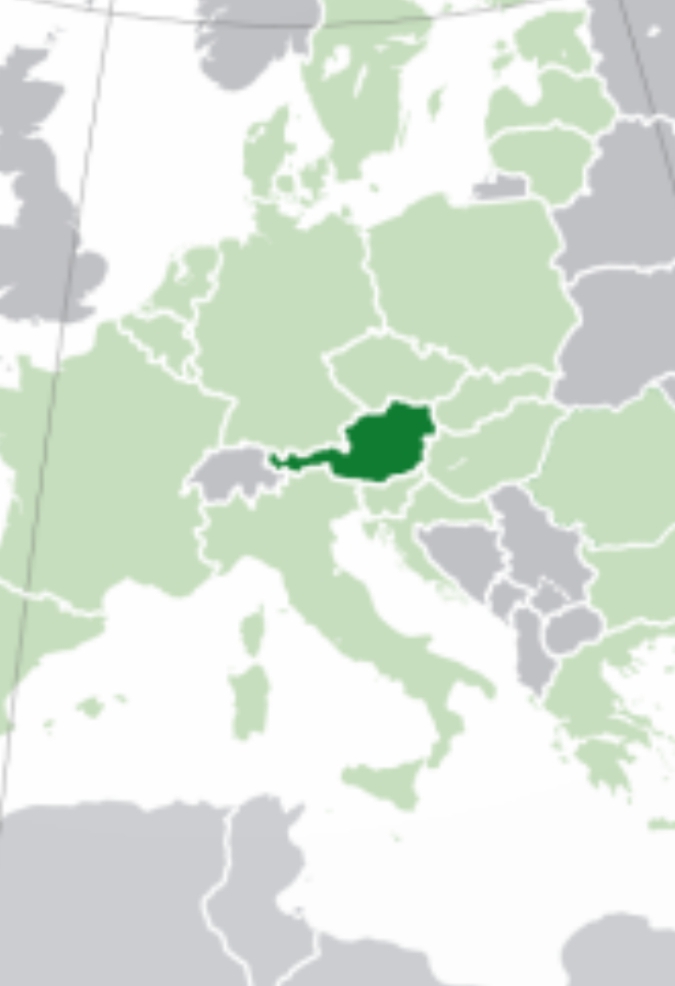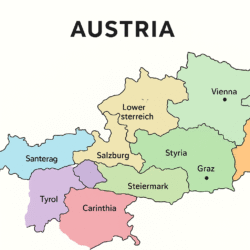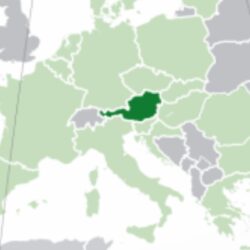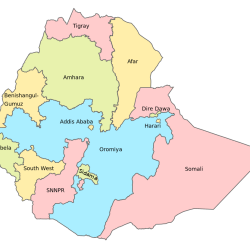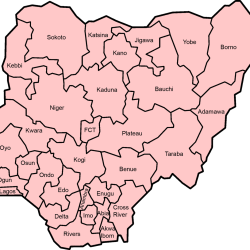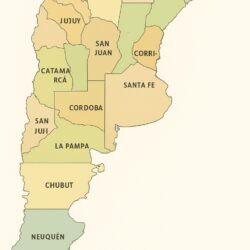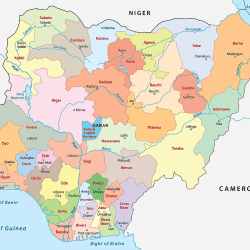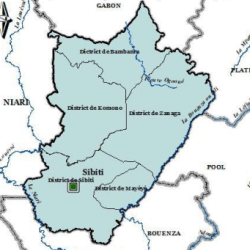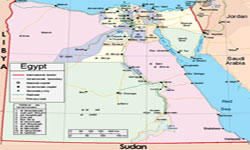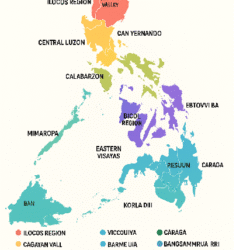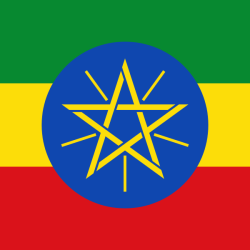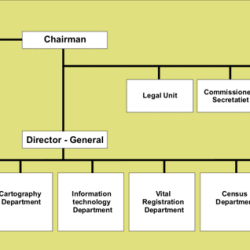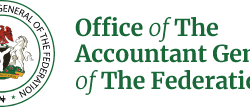Administrative Divisions of the Republic of Austria
The administrative structure of Austria is characterised by a federal-state system that operates across multiple levels of government. Below is a detailed overview of how the territory is organised, the legal basis of the divisions, key statistics, and the implications for governance and administration.
1. Overview and Legal Basis
Austria is a federal republic composed of nine constituent units called Bundesländer (federal states or provinces).
The current key constitutional framework is the Federal Constitutional Law (Bundes-Verfassungsgesetz, B-VfG) which enshrines the federal principle (Art. 2 B-VfG) and provides for the division of competences between the federal (Bund) and state (Land) levels.
In practice, Austria’s federalism is often characterised as “weak” compared to other federal states, because a large number of significant powers (especially at legislative level) are held by the federal government.
Administration and public tasks are organised across four tiers:
- Federal level (the Bundesregierung and federal ministries)
- State (Land) level – the nine Länder
- District (Bezirk) level and statutory cities (Statutarstädte)
- Municipal level (Gemeinden)
2. The Nine Federal States (Länder)
Here are the nine Länder, each with their own capital, area, population and some economic data (based on available 2022 / earlier statistics).
| State (Land) | Capital | Area (km²) | Population* | Notes / GDP per capita |
|---|---|---|---|---|
| Burgenland | Eisenstadt | ~3,965 | ~291,942 | GDP per capita ~ €34,900 |
| Carinthia (Kärnten) | Klagenfurt | ~9,536 | ~561,077 | GDP per capita ~ €43,600 |
| Lower Austria (Niederösterreich) | Sankt Pölten | ~19,178 | ~1,665,753 | GDP per capita ~ €41,900 |
| Salzburg (state) | Salzburg | ~7,154 | ~549,263 | GDP per capita ~ €58,900 |
| Styria (Steiermark) | Graz | ~16,401 | ~1,237,298 | GDP per capita ~ €44,600 |
| Tyrol (state) (Tirol) | Innsbruck | ~12,648 | ~746,153 | GDP per capita ~ €51,200 |
| Upper Austria (Oberösterreich) | Linz | ~11,982 | ~1,465,045 | GDP per capita ~ €50,700 |
| Vienna (Wien) | Vienna | ~415 | ~1,867,582 | GDP per capita ~ €56,600 |
| Vorarlberg | Bregenz | ~2,601 | ~388,752 | GDP per capita ~ €58,300 |
*Population numbers correspond to the data cited (1 Jan 2017 in the main table).
Each Land has its own Landtag (state parliament) and Landesregierung (state government) headed by a Landeshauptmann/-frau (governor).
3. State Subdivisions: Districts, Statutory Cities and Municipalities
Districts (Bezirke) and Statutory Cities (Statutarstädte)
Within each Land, there is a further subdivision into political districts (politische Bezirke or Verwaltungsbezirke) and statutory cities. A statutory city is a municipality which by law has both municipal and district administrative functions.
As of 2017 there are 94 such districts in Austria: 79 headed by district commissions (Bezirkshauptmannschaften) and 15 statutory cities.
For example, the Land of Vienna is unique because it is both a Land and a statutory city.
Municipalities (Gemeinden)
Below the district/statutory city level are municipalities — the basic local government units responsible for local services, zoning, local roads, etc. The number of municipalities varies by Land.
Hierarchy Summary
- Level 1: Federal (Nation)
- Level 2: State (Land)
- Level 3: District (Bezirk) or Statutory City
- Level 4: Municipality (Gemeinde)
4. Distribution of Powers and Fiscal Aspects
The division of legislative and administrative tasks between the federal and state levels is regulated in Articles 10-12 and 15 of the B-VfG.
In broad terms:
- The federal government (Bund) holds the main legislative powers in areas like defence, foreign policy, income tax, VAT, judiciary, telecommunications.
- The states (Länder) have legislative competence in certain policy areas, and administrative/implementation competence for some federal laws (“indirect administration”). The states also have their own budgets, can levy some local taxes/rates, and manage local administration.
- A revenue-sharing system exists: although major taxes (income tax, VAT) are collected at federal level, the federal government transfers funds to the Länder and municipalities.
The “Kompetenzbereinigung” reform (effective January 2020) further clarified and reallocated competences between the Bund and the Länder.
5. Key Statistics & Observations
- The nine Länder vary widely in area, population and economic strength (see table above).
- The Land of Vienna, despite its small area (~415 km²) has the highest population and highest population density — reflecting its status as both a city and a federal state.
- Some Länder, particularly in mountainous western Austria (Tyrol, Vorarlberg), have smaller populations but often higher GDP per capita due to tourism and specialised industries.
- Most of the country’s low‐lying and agriculturally productive land lies in the eastern states (Lower Austria, Burgenland) along the Danube valley, while the western states are more mountainous (Alps).
6. Practical Implications & Governance Aspects
Identity and regional loyalty: Despite the relatively centralised nature of the Austrian system, regional identity remains strong. Many Austrians identify with their Land as much (or more) than with Austria as a whole.
Administrative reform: Discussions continue on administrative simplification, digitalisation and the role of the Länder and municipalities in implementing EU directives and federal policies.
Local government and municipalities: At the municipal level, local councils handle community matters, local planning and services. The variation in municipality size means some rural areas have very small municipalities, which raises issues of cost-efficiency and service delivery.
Statutory cities: These cities combine municipal and district level functions — which can streamline administration in more urbanised settings. For example, the city administration also handles duties that elsewhere would be run by a separate district authority.
7. Summary
The administrative divisions of Austria reflect a layered, federal structure: nine Länder form the second tier of government beneath the federal level, each with their own government and limited legislative autonomy. Beneath the Länder are districts and municipalities, forming the local governance structure. While the system is federal in form, in practice the federal (Bund) holds significant powers, and much of the administration is shaped by cooperation between the levels of government. The design supports regional diversity (in terms of geography, economy and culture) while maintaining coherence at the national level.
